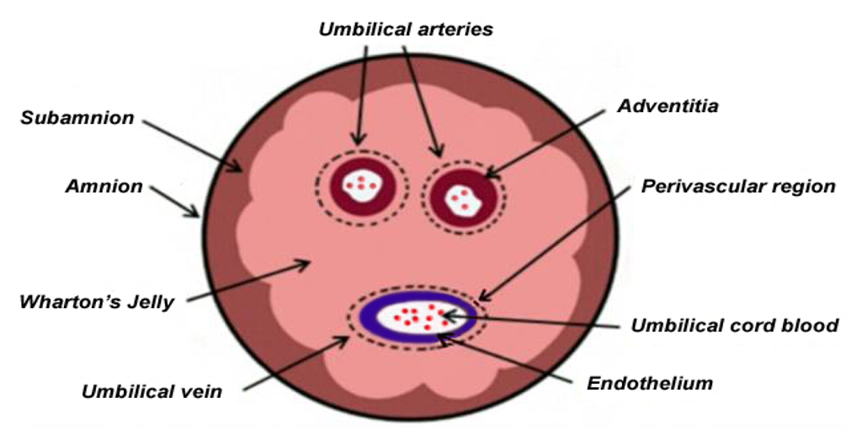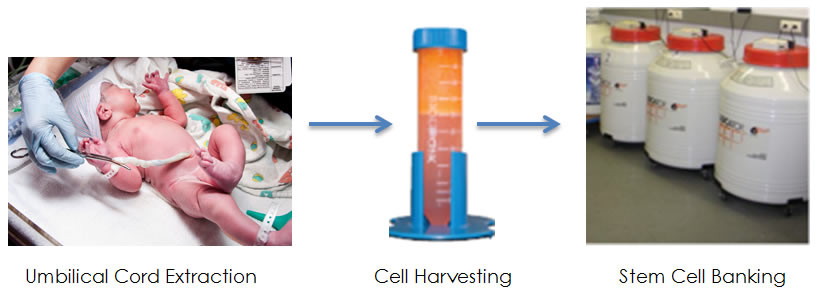Wharton's Jelly and its stem cell

The human umbilical cord consists of two arteries and one vein buried within the Wharton’s Jelly, a mucoid connective tissue and fibroblast-like cells that channel between the evolving embryo or fetus and the placenta. Wharton’s Jelly contains a profuse amount of Mesenchymal Stem Cells (MSCs).
In the 1950s, scientists have discovered that there are generally two kinds of adult stem cells: the Hematopoietic Stem Cells (HSCs) and MSCs, found mostly in bone marrow. HSCs are also found in peripheral blood and cord blood and are widely being used in treating cancers of blood such as leukemia and lymphoma.
Meanwhile, MSCs are the most significant source of adult stem cells that are involved in the regeneration of tissues with mesenchymal origin such as the bone, cartilage, muscle, tendon and adipose tissue.
References- Saeidi. M, et al. Immunomodulatory Effects of Human Umbilical Cord Wharton’s Jelly-Derived Mesenchymal Stem Cells on Differentiation, Maturation and Endocytosis of Monocyte-Derived Dendritic Cells, March 2013; 12(1): 37-49.
- Dae-Won Kim, et al. Wharton’s Jelly-Derived Mesenchymal Stem Cells: Phenotypic Characterization and Optimizing Their Therapeutic Potential for Clinical Applications, 2013, 14(6), 11692-11712.
Why Wharton's Jelly MSC?

Wharton's Jelly is a rich source of multi-potent stem cells. Wharton's Jelly Mesenchymal stem cells (MSCs) is increasingly becoming the preferential source of stem cells due to their relatively easier accessibility (large donor pool), non-invasive harvesting procedures with minimum risk and no discomfort to the donor. Not only it is high in vitro expandable rates and multipotent differential prospective, there are also no (ethical, race or religion) controversies surrounding the harvesting of Wharton’s Jelly.
The ability of such MSCs to differentiate into ectoderm/mesoderm/endoderm-derived cells implies that they contain promising latent regenerative characteristics medicine impending in several diseases. Current studies are steered towards taking full advantage of these distinctive properties for specific indications. The immunosuppressive ability of these cells provides potential lead in treating disorders such as graft-versus-host disease (GvHD), diabetes, Crohn’s disease, heart disease and solid tumor cancers.
For example, GvHD is a common complication succeeding a stem cell transplant from an unrelated donor. Due to MSCs distinctive immune properties, they showed a promising treatment possibility for steroid-refractory GvHD (when GvHD does not respond to steroids or is not resolved by steroids). Studies have also shown that MSCs verge to suppress autoimmune reactions and therefore, could potentially suppress the divergence between the graft and host immune systems.
Reference- http://himedialabs.com/TD/CL001.pdf
- Anzalone. R, et al., Wharton’s Jelly Mesenchymal Stem Cells as Candidates for Beta Cells Regeneration: Extending the Differentiative and Immunomodulatory Benefits of Adult Mesenchymal Stem Cells for the Treatment of Type 1 Diabetes, June 2011, Volume 7, Issue 2, pp 342-363
- http://kwt.smartcells.com/blog/2014/12/19/first-west-msc-cord-tissue-used-treat-graft-versus-host-disease/
- Corotchi, M.C, et al., Isolation method and xeno-free culture conditions influence multipotent differentiation capacity of human Wharton's Jelly-derived mesenchymal stem cells, Stem Cell Research & Therapy 2013, 4:81
- R.R. Taghizadeh*, K.J. Cetrulo and C.L. Cetrulo, Wharton's Jelly stem cells: Future clinical applications, 16 June 2011, doi:10.1016/ j.placenta.2011.06.010
How do we store Wharton's Jelly MSC?
Storing Wharton's Jelly Mesenchymal Stem Cell (MSCs) is a painless procedure that is only available during birth. Upon delivery, a section of the umbilical cord shall be harvested and transported to our laboratory for further processing by our professional laboratory technicians using proprietary know-hows. Once the mesenchymal stem cells are successfully extracted from the Wharton’s Jelly found inside the cord, they would be cryo-preserved in our facility for our clients’ possible future needs.


 +603-4050 5509
+603-4050 5509